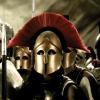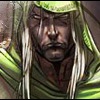Man Made Ruins:
Creating unique ruined environments
When planning ruins on your map, whether at a large city, or on a smaller scale, it’s important to keep one thing in mind: ruins weren’t always ruins. They used to be buildings.
It seems obvious i know, but the best maps will often have their ruins placed in some semblance of a planned city, and not just random clumps of buildings. This is especially important in city-like areas, as unit pathing and combat areas become increasingly important as you place more buildings. Make sure you have enough space for units to fight in built up areas – an open town square or main street gives your players a chance to swing their swords.
{IP} Aridor Arthain's Lake Evendim map is a perfect example of placing ruins to suggest a building that has long since been lost to time
Whenever placing objects as a mapper, it is always important to use a variety of objects in your map. This can be especially important when using man-made structures, as the various sets of structures (e.g. Osgiliath, Ithilien or Amon Hen) are quite recognisable. Therefore, you have to be extra creative in your use of these objects when creating ruins that may not necessarily relate to the original locations of the structures.
An small selection of the Amon Hen, Ithilien and Osgiliath props available in BFME 1. Each set has distinctive features that may or may not suit your map
Your research/concepts of your area will help determine which set of objects to use. For example, ruins in Eriador, such as Fornost or Annuminas, will require the use of Gondorian/Numenorian type ruins, such as the Osgiliath or Ithilien sets. You can also use Gondor, Cirith Ungol, Minas Tirith and Helm’s Deep objects to good effect, as long as you find innovative ways to ‘disguise’ their use.
Have a look at Lake Evendim by {IP} Aridor Arthain, or my “Fornost” map:

The use of the Osgiliath and Ithilen props to ‘disguise’ the Gondor and Minas Tirith Walls works effectively, allowing you to create infinite unique arrangements of ruined structure (and that’s before you add things like rocks, rubble, trees, grasses and man-made props to spice things up even more). The varied use of scale, z-heights and prop placement, means that despite using the same set of structures, these two maps have their own unique style, different to EA’s Osgiliath map.
Here i’ve used a variety of Minas Tirith and Gondor walls to form the basis for my city structure. Then, using the ruined objects from Osgiliath and Ithilien, i painstakingly covered over the surface of each wall (though not the tops for pathing reasons).
Using a mixture of vertical pillars and horizontal walls was important, in order to break up the repetition of certain wall objects.
In contrast, here’s a look at my Fornost map with and without any of the extra ruins. I could have left the map in a less intricate state, as the walls are all walkable and serve their purpose of dividing up the terrain. However, playing a map left at this stage would quickly grow old, as you would begin to think of the map as some generic, snowy, Gondor map, rather than “Fornost”. 

It really comes down to what you are trying to achieve. If you are making an Osgiliath map (like snoopyzero’s East Osgiliath map), then by all means, go nuts with the Osgiliath props. But don't feel limited to Osgiliath, Ithilien or Amon Hen ruins. Snoopyzero has used damaged gondor buildings and structures to add a nice variety to his objects.

But if you are trying to recreate a more unique location, then you’ll have to place your objects creatively to achieve a more unique look.
Because really, the maps that you love to play over and over are the ones that have unique, interesting, eye-popping aesthetics to match the gameplay.
That’s it for now, please comment and let me know what you thought ![]()
Next time, a look at creating realistic cliff terrain
Edited by Puppeteer, 26 May 2010 - 10:05 AM.





































